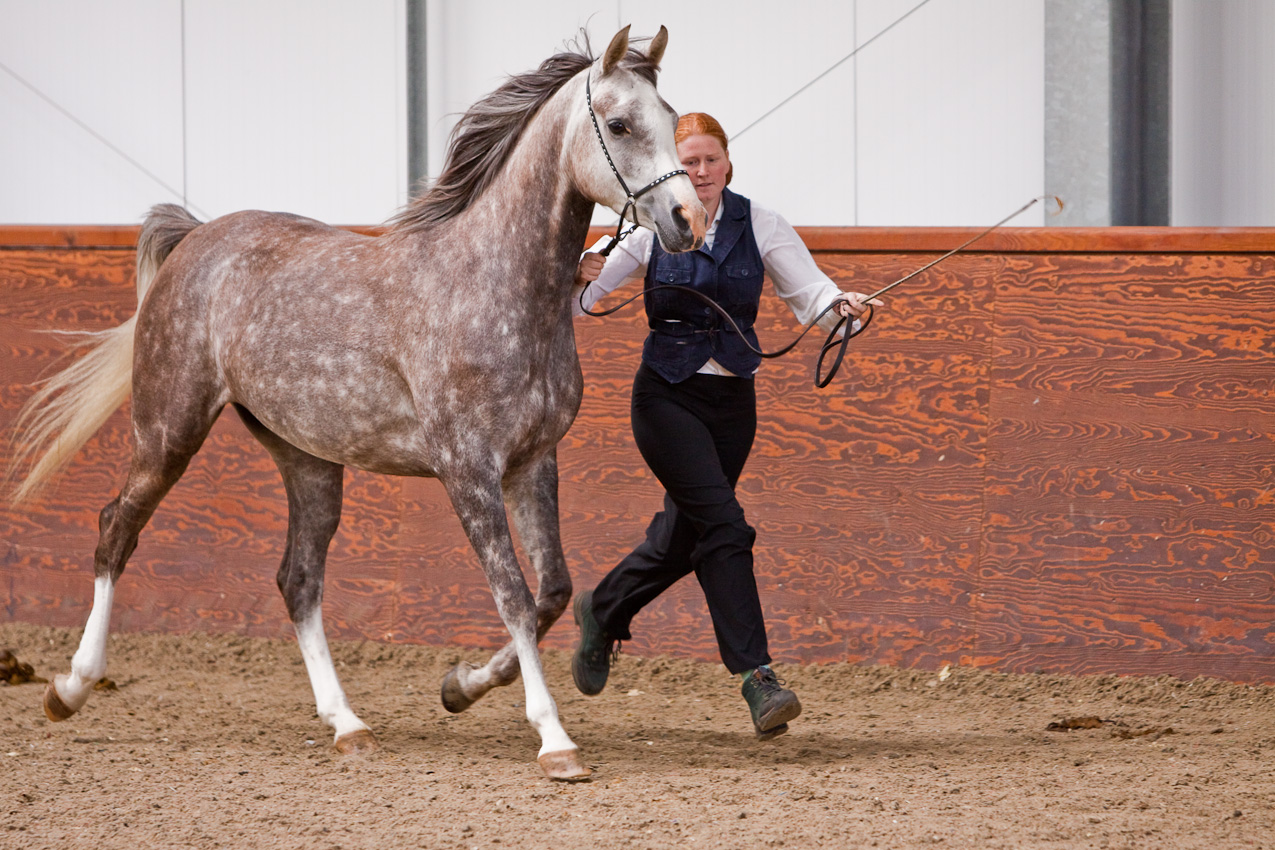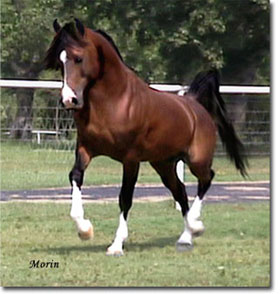Arabian Horses Pictures Biography
Source(Gogle.com.pk)From Wikipedia, the free encyclopedia
For the GusGus album, see Arabian Horse (album).
This is a good article. Click here for more information.
Arabian horse
An Arabian Mare
Distinguishing features finely chiseled bone structure, concave profile, arched neck, comparatively level croup, high-carried tail.
Alternative names Arabian, Arab
Country of origin Developed in the Middle East, most notably Arabian peninsula
Breed standards
Arabian Horse Association (USA) Breed standards
The Arabian Horse Society of Australia Breed standards
The Arab Horse Society (UK) Breed standards
World Arabian Horse Organization Breed standards
Horse (Equus ferus caballus)
The Arabian or Arab horse (Arabic: الحصان العربي [ ħisˤaːn ʕarabiː], DMG ḥiṣān ʿarabī) is a breed of horse that originated on the Arabian Peninsula. With a distinctive head shape and high tail carriage, the Arabian is one of the most easily recognizable horse breeds in the world. It is also one of the oldest breeds, with archaeological evidence of horses in the Middle East that resemble modern Arabians dating back 4,500 years. Throughout history, Arabian horses spread around the world by both war and trade, used to improve other breeds by adding speed, refinement, endurance, and strong bone. Today, Arabian bloodlines are found in almost every modern breed of riding horse.
The Arabian developed in a desert climate and was prized by the nomadic Bedouin people, often being brought inside the family tent for shelter and protection from theft. Selective breeding for traits including an ability to form a cooperative relationship with humans created a horse breed that is good-natured, quick to learn, and willing to please. The Arabian also developed the high spirit and alertness needed in a horse used for raiding and war. This combination of willingness and sensitivity requires modern Arabian horse owners to handle their horses with competence and respect.
The Arabian is a versatile breed. Arabians dominate the discipline of endurance riding, and compete today in many other fields of equestrian activity. They are one of the top ten most popular horse breeds in the world. They are now found worldwide, including the United States and Canada, the United Kingdom, Australia, continental Europe, South America (especially Brazil), and its land of origin, the Middle East.
Contents [hide]
1 Breed characteristics
1.1 Skeletal analysis
1.2 Size
1.3 Temperament
1.4 Colors
1.4.1 Gray and white
1.4.2 Sabino
1.4.3 Rabicano or roan?
1.4.4 Colors that do not exist in purebreds
1.5 Genetic disorders
2 Mythology
3 Origins
3.1 Desert roots
3.2 Strains and pedigrees
4 Historic development
4.1 Role in the ancient world
4.2 In Islamic history
4.3 Egypt
5 Arrival in Europe
5.1 Polish and Russian breeding programs
5.2 Central and western Europe
5.3 Rise of the Crabbet Park Stud
5.4 Early 20th-century Europe
5.5 Modern warfare and its impact on European studs
5.6 After the Cold War
6 In America
6.1 Early imports
6.2 Development of purebred breeding in America
6.3 Modern trends
7 In Australia
7.1 Early imports
7.2 In the 20th and 21st centuries
8 Modern breeding
9 Influence on other horse breeds
10 Uses
10.1 Competition
10.2 Other activities
11 Notes
12 References
13 Further reading
14 External links
Breed characteristics[edit]
A light gray horse moving at a trot through an arena with all four feet off the ground. The tail is carried high and the neck is arched.
A purebred Arabian stallion, showing dished profile, arched neck, level croup and high-carried tail
See also: Horse anatomy
Arabian horses have refined, wedge-shaped heads, a broad forehead, large eyes, large nostrils, and small muzzles. Most display a distinctive concave, or "dished" profile. Many Arabians also have a slight forehead bulge between their eyes, called the jibbah by the Bedouin, that adds additional sinus capacity, believed to have helped the Arabian horse in its native dry desert climate.[1][2] Another breed characteristic is an arched neck with a large, well-set windpipe set on a refined, clean throatlatch. This structure of the poll and throatlatch was called the mitbah or mitbeh by the Bedouin. In the ideal Arabian it is long, allowing flexibility in the bridle and room for the windpipe.[2]
Other distinctive features are a relatively long, level croup, or top of the hindquarters, and naturally high tail carriage. The USEF breed standard requires Arabians have solid bone and standard correct equine conformation.[3] Well-bred Arabians have a deep, well-angled hip and well laid-back shoulder.[4] Within the breed, there are variations. Some individuals have wider, more powerfully muscled hindquarters suitable for intense bursts of activity in events such as reining, while others have longer, leaner muscling better suited for long stretches of flat work such as endurance riding or horse racing.[5] Most have a compact body with a short back.[2] Arabians usually have dense, strong bone, and good hoof walls. They are especially noted for their endurance,[6][7] and the superiority of the breed in Endurance riding competition demonstrates that well-bred Arabians are strong, sound horses with superior stamina. At international FEI-sponsored endurance events, Arabians and half-Arabians are the dominant performers in distance competition.[8]
Skeletal analysis[edit]
A defleshed skeleton of a horse put together in a standing position.
Mounted skeleton of an Arabian horse, showing underlying structure of breed characteristics including short back, high-set tail, distinction between level croup and well-angulated hip. This specimen also has only 5 lumbar vertebrae.
Some Arabians, though not all, have 5 lumbar vertebrae instead of the usual 6, and 17 pairs of ribs rather than 18.[9] A quality Arabian has both a relatively horizontal croup and a properly angled pelvis as well as good croup length and depth to the hip (determined by the length of the pelvis), that allows agility and impulsion.[4][10] A misconception confuses the topline of the croup with the angle of the "hip" (the pelvis or ilium), leading some to assert that Arabians have a flat pelvis angle and cannot use their hindquarters properly. However, the croup is formed by the sacral vertebrae. The hip angle is determined by the attachment of the ilium to the spine, the structure and length of the femur, and other aspects of hindquarter anatomy, which
Arabian Horses Pictures for Kids Black and White to Color Funny Hd Wallpapepr Images Pics
Arabian Horses Pictures for Kids Black and White to Color Funny Hd Wallpapepr Images Pics
Arabian Horses Pictures for Kids Black and White to Color Funny Hd Wallpapepr Images Pics

Arabian Horses Pictures for Kids Black and White to Color Funny Hd Wallpapepr Images Pics
Arabian Horses Pictures for Kids Black and White to Color Funny Hd Wallpapepr Images Pics

Arabian Horses Pictures for Kids Black and White to Color Funny Hd Wallpapepr Images Pics
Arabian Horses Pictures for Kids Black and White to Color Funny Hd Wallpapepr Images Pics
.jpg)
Arabian Horses Pictures for Kids Black and White to Color Funny Hd Wallpapepr Images Pics
Arabian Horses Pictures for Kids Black and White to Color Funny Hd Wallpapepr Images Pics
Arabian Horses Pictures for Kids Black and White to Color Funny Hd Wallpapepr Images Pics
Arabian Horses Pictures for Kids Black and White to Color Funny Hd Wallpapepr Images Pics

Arabian Horses Pictures for Kids Black and White to Color Funny Hd Wallpapepr Images Pics

Arabian Horses Pictures for Kids Black and White to Color Funny Hd Wallpapepr Images Pics
Arabian Horses Pictures for Kids Black and White to Color Funny Hd Wallpapepr Images Pics

Arabian Horses Pictures for Kids Black and White to Color Funny Hd Wallpapepr Images Pics

No comments:
Post a Comment